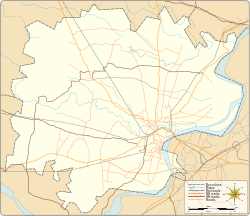Banaras Hindu University
 The seal of Banaras Hindu University, depicting Goddess Saraswati. | |
Former name | Central Hindu College |
|---|---|
| Motto | Vidyayā'mritamașnute |
Motto in English | "Knowledge imparts immortality" |
| Type | Public |
| Established | 1916 |
| Founder | Madan Mohan Malaviya |
| Chancellor | Karan Singh |
| Vice-Chancellor | mahesh bhtnagar [1] |
| Students | 27,359 (2016–17) |
| Undergraduates | 14,476 |
| Postgraduates | 9,117 |
| 3,766 | |
| Location | Varanasi, Uttar Pradesh, India |
| Campus | Urban and Rural |
| Affiliations | |
| Mascot | Goddess Saraswati |
| Website |
bhu |
Banaras Hindu University (Hindi: [kaʃi hind̪u viʃvəvid̪yaləy], BHU), formerly Central Hindu College, is a public central university located in Varanasi, Uttar Pradesh. It was established in 1916 by Madan Mohan Malaviya.[2] With over 30,000 students residing in campus, it claims the title of largest residential university in Asia.[3]
The university's main campus spread over 1,300 acres (5.3 km2) was built on land donated by the Kashi Naresh, the hereditary ruler of Banaras ("Kashi" being an alternative name for Banaras or Varanasi). The Banaras Hindu University, South campus, spread over 2,700 acres (11 km2),[4] hosts the Krishi Vigyan Kendra (Agriculture Science Centre)[5] and is located in Barkachha in Mirzapur district, about 60 km (37 mi) from Banaras. The University is also planning to set up a campus in Bihar.[6]
BHU is organised into 6 institutes and 14 faculties (streams) and about 140 departments.[7][8] As of 2017, the total student enrollment at the university is 27,359[9] coming from 48 countries.[10] It has over 75 hostels for resident students. Several of its faculties and institutes include arts (FA-BHU), engineering (IIT-BHU), management (IMSt.-BHU), science (I.Sc. - BHU), performing arts, law, agriculture (IAS-BHU), medicine (IMS-BHU) and Institute of Environment And Sustainable Development (IESD-BHU) along with departments of linguistics, journalism & mass communication, among others. The university's engineering institute was designated an Indian Institutes of Technology in June 2012.
BHU celebrated its centenary year in 2015-2016. The Centenary Year Celebration Cell organised various programs including cultural programs, feasts & competitions & Mahamana Madan Mohan Malviya Birth Anniversary on 25 December 2015.[11]
History
The Banaras Hindu University was established by Madan Mohan Malviya. A prominent lawyer and an Indian independence activist, Malviya considered education as the primary means for achieving a national awakening.[12]
At the 21st Conference of the Indian National Congress in Benares in December 1905, Malviya publicly announced his intent to establish a university in Varanasi. On the request of Malviya, Attar Singh laid the foundation stone of Banaras Hindu University at Varanasi in 1914. Malviya continued to develop his vision for the university with inputs from other Indian nationalists and educationists. He published his plan in 1911. The focus of his arguments was the prevailing poverty in India and the decline in income of Indians compared to Europeans. The plan called for the focus on technology and science, besides the study of India's religion and culture:
"The millions mired in poverty here can only get rid (of it) when science is used in their interest. Such maximum application of science is only possible when scientific knowledge is available to Indians in their own country."[13]
Malviya's plan evaluated whether to seek government recognition for the university or operate without its control. He decided in favour of the former for various reasons. Malviya also considered the question of medium of instruction and decided to start with English given the prevalent environment, and gradually add Hindi and other Indian languages. A distinguishing characteristic of Malviya's vision was the preference for a residential university. All other Indian universities of the period, such as the universities in Bombay, Calcutta, Madras, etc., were affiliating universities which only conducted examinations and awarded degrees to students of their affiliated colleges.[13]
Around the same time, Annie Besant was also trying to expand her Central Hindu School and establish a university. Established in 1898 in the Kamachha area of Varanasi, the vision behind the school was that there should be learning institutions based on Hindu philosophy.[14] Malviya had supported Besant's cause and in 1903, he had raised 250,000 Rupees in donations to finance the construction of the school's hostel.[15] In 1907 Besant had applied for a royal charter to establish a university. However, there was no response from the British government.
Following the publication of Malviya's plan, Besant met Malviya and in April 1911 they agreed to unite their forces to build the university in Varanasi.[16]
Malviya soon left his legal practice to focus exclusively on developing the university and his independence activities.[17] On 22 November 1911, he registered the Hindu University Society to gather support and raise funds for building the university.[18] He spent the next 4 years gathering support and raising funds for the university. Malviya sought and received early support from the Kashi Naresh Prabhu Narayan Singh and Maharaja Sir Rameshwar Singh Bahadur of Raj Darbhanga.[14] Thakur Jadunath Singh of Arkha along with other noble houses of United Provinces contributed for the development of the University.
In October 1915, with support from Malviya's allies in the Indian National Congress, the Banaras Hindu University Bill was passed by the Imperial Legislative Council.[19]
BHU was finally established in 1916, the first university in India that was the result of a private individual's efforts. The foundation for the main campus of the university was laid by Lord Hardinge, the then Viceroy of India, on Vasant Panchami 4 February 1916.[16][20] To promote the university's expansion, Malviya invited eminent guest speakers such as Mahatma Gandhi, Sir Jagadish Chandra Bose, Prof C. V. Raman, Prafulla Chandra Roy, Prof Sam Higginbottom, Sir Patrick Geddes, and Besant to deliver a series of what are now called The University Extension Lectures between 5–8 February 1916. Gandhi's lecture on the occasion was his first public address in India.[20]
Sir Sunder Lal was appointed the first Vice-Chancellor, and the university began its academic session[2] the same month with classes initially held at the Central Hindu School in the Kamachha area, while the campus was being built on over 1,300 acres (5.3 km2) of land donated by the Kashi Naresh on the outskirts of the city. The Nizam of Hyderabad and Berar, Mir Osman Ali Khan, also made a donation of ₹1 lakh for the university.[21][22][23]
The university's anthem, known as the Kulgeet, was composed by Shanti Swarup Bhatnagar.[24]
Campus
Main campus
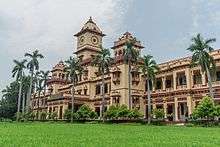
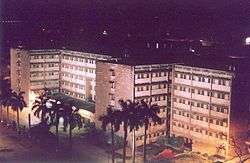
BHU is located on the southern edge of Varanasi, near the banks of the river Ganges. Development of the main campus, spread over 1,300 acres (5.3 km2), started in 1916 on land donated by the then Kashi Naresh Prabhu Narayan Singh. The campus layout approximates a semicircle, with intersecting roads laid out along the radii or in arcs. Buildings built in the first half of the 20th century are fine examples of Indo-Gothic architecture.
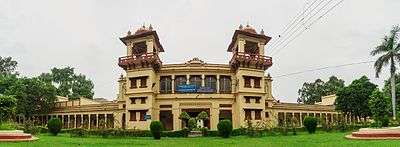
The campus has over 60 hostels offering residential accommodation for over 12,000 students.[25] On-campus housing is also available to a majority of the full-time faculty.
The Sayaji Rao Gaekwad Library is the main library on campus and houses over 1.3 million volumes as of 2011. Completed in 1941, its construction was financed by Maharaja Sayajirao Gaekwad III of Baroda. In addition to the main library, there are three institute libraries, eight faculty libraries and over 25 departmental libraries available to students and staff.
Sir Sunderlal Hospital on the campus is a teaching hospital for the Institute of Medical Sciences. Established in 1926 with 96 beds, it has since been expanded to over 900 beds and is the largest tertiary referral hospital in the region.
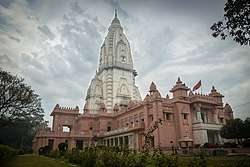
The most prominent landmark is the Shri Vishwanath Mandir, located in the centre of the campus. The foundation for this 252 feet (77 m) high complex of seven temples was laid in March 1931, and took almost three decades to complete.[27]
Bharat Kala Bhavan is an art and archaeological museum on the campus. Established in January 1920, its first chairman was Nobel laureate Rabindranath Tagore, with his nephew Abanindranath Tagore as the vice-chairman. The museum was expanded and gained prominence with the efforts of Rai Krishnadasa.[28] The museum is best known for its collection of Indian paintings, but also includes archaeological artefacts, textiles and costumes, Indian philately as well as literary and archival materials.[29] The Alice Boner Gallery was also set up at Bharat Kala Bhavan with the assistance of the Alice Boner Foundation in 1989 to mark the birth centenary of Alice Boner.[30]
Rajiv Gandhi South Campus
The Banaras Hindu University, South campus is located in Barkachha in Mirzapur district,[4] about 60 km (37 mi) southwest of the main campus. Spread over an area of over 2,700 acres (11 km2), it was transferred as a lease in perpetuity to BHU by the Bharat Mandal Trust in 1979.[31]
It hosts the Krishi Vigyan Kendra (Agricultural Science Centre), with focus on research in agricultural techniques, agro-forestry and bio-diversity appropriate to the Vindhya Range region.[32] The South Campus features a lecture complex, library, student hostels and faculty housing, besides administrative offices.[33]
The Banaras Hindu University has extended its outreach by establishing its South Campus at Barkachha in Mirzapur district. The RGSC is being developed as a potential hub for education, training and entrepreneurship for youth and women, especially those belonging to tribes and weaker sections of the society.
The campus is being developed by the University with a mission to enrich the lives of the population of the region by extending to them opportunities to engage in lifelong learning and to benefit from the result of research.
Academics
BHU is organised into 6 institutes and 14 Faculties (Streams). The institutes are administratively autonomous, with their own budget, management and academic bodies.[34]
Institutes
Indian Institute of Technology (BHU) Varanasi
The Indian Institute of Technology (BHU) Varanasi (IIT-BHU) is an engineering institute under the aegis of BHU. IIT-BHU has 14 departments and 3 inter-disciplinary schools,[35] providing technology education with an emphasis on its industrial applications. Established in 1919, it is one of the oldest engineering institutes in India.[36] The institute in its present form was created by the merger of three BHU colleges – the Banaras Engineering College, the College of Mining and Metallurgy, and the College of Technology.
It was designated an Indian Institute of Technology (IIT) by The Institutes of Technology (Amendment) Act, 2012[37] of Parliament in 2012[38] and is declared as Institute of National Importance by Government of India under IIT Act.[39]
Institute of Science
The Institute of Science comprises 13 departments covering various branches of modern science, and several inter-disciplinary schools and research centres. It offers undergraduate, postgraduate and Ph.D. in most disciplines, M.Sc. (Tech.) in Geophysics, MCA, and conducts research programmes in all areas.Two vocational courses, Industrial Microbiology and Electronics Instrumentation and Maintenance have been introduced in recent years at U.G. level. Bitrex is its annual technical fest and Aakanksha is its annual cultural fest organize every year in the month of February.
Institute of Agricultural Sciences
The Institute of Agricultural Sciences (IAS) was founded as Institute of Agricultural Research in 1931 and was the first institute in India to provide postgraduate programs (M.Sc. and PhD) in agricultural science. In 1945, undergraduate degrees were introduced and it was renamed as the College of Agriculture. It was renamed as the Faculty of Agriculture in 1968 and was raised to the status of the Institute of Agricultural Sciences in August 1980. It is involved in both education and research in agricultural science.[40]
Institute of Medical Sciences
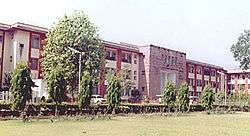
The Institute of Medical Sciences (IMS) is a residential, co-educational medical institute. It admits students for its programs in medicine through the NEET entrance examination held across India. In addition to the MBBS programs, it offers specialisations and PhD programs for physicians in medicine and surgery. It also offers graduate and post-graduate programs in Nursing, Ayurvedic medicine, Dentistry and Health Statistics. It is one of the finest institutes in the country. It produces some of the best physicians and results across the country. There are three faculties viz. Medicine, Ayurveda and Dental Sciences.
Institute of Environment & Sustainable Development
The Institute of Environment & Sustainable Development (IESD) aiming to develop and advance the knowledge of technology and processes for sustainable development was started in the year 2010 in the tenure of the then Vice-Chancellor of BHU, D.P. Singh.[41]
In accordance with the UN visualization that higher education should contribute significantly to the development of appropriate knowledge and competencies in the area of sustainable development, a nation-level Institute of Environment & Sustainable Development has been established in the Banaras Hindu University. The institute will cover education about sustainable development (developing an awareness of what is involved) and education for sustainable development (using education as a tool to achieve sustainability). The institute will be dedicated to a better understanding of critical scientific and social issues related to sustainable development goals through guided research.[42]
Institute of Management Studies
The Institute of Management Studies is the business school of Banaras Hindu University. Established in 1968 as the Faculty of Management Studies (FMS, BHU), it is among the earliest management schools in India. It was renamed to its current name on 16 December 2015.[43]
The institute offers several two-year Master of Business Administration (MBA) programmes. Admission is based on the combined merit acquired by a candidate in CAT, group discussion and interview. Eligibility requirements are a graduate degree under 10+2+3 Pattern / degree in Agriculture, Technology, Medicine, Education or Law / Post-graduate degree in any discipline under 10+2+3+2 pattern from any Indian University/Institution recognized by AIU/AICTE with at least 50% marks in aggregate (at least 45% for SC/ST candidates).
Faculties
Academic faculties of the university include:[44]
Faculty of Social Sciences
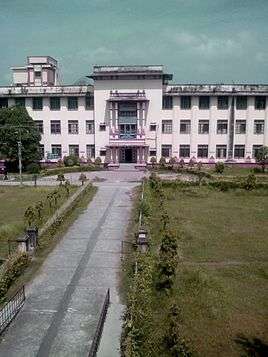
The Faculty of Social Sciences offers undergraduate and postgraduate courses in Social science. It was bifurcated from the Faculty of Arts in 1971. It includes the depatrtments of Economics, History, Political Science, Psychology and Sociology.[45]
Other than the departments, there are five centres which carry on the studies in various fields, namely the Centre for the Study of Nepal, Centre for Women's Study and Development, Centre for Integrated Rural Development, Centre for the Study of Social Exclusion and Inclusion Policy and the Malviya Centre for Peace Research.[46]
The faculty holds three chairs, the currently (as of 2018) vacant Babu Jagjivan Ram Chair for Social Research, commemorating Jagjivan Ram and his contributions,[47] the Dr. Ambedkar Chair for Nationalism & National Integration established in 2016[48] and the Pt. Deendayal Upadhyay Chair, established in 2017.[49]
Faculty of Visual Arts
The Faculty of Visual Arts offers undergraduate and postgraduate courses in applied and visual arts. It was founded in 1916.[50] It includes five departments:
- Painting
- Applied arts
- Plastic arts
- Pottery and Ceramics
- Textile designing
Inter-disciplinary schools
School of Biotechnology
.jpg)
The School of Biotechnology (SBT) is a center for postgraduate teaching and research under the aegis of Institute of Science of the BHU.[51][52] It was established in 1986 with funding from the Department of Biotechnology,[53] of the Ministry of Science and Technology, Government of India. It offers MSc and PhD programmes in Biotechnology.
The interdisciplinary program involves the partnership between the Institute of Science, the Institute of Medical Sciences and the Indian Institute of Technology at BHU. Notable faculty include Arvind Mohan Kayastha.[54]
DBT-BHU Interdisciplinary School of Life Sciences
The Interdisciplinary School of Life Sciences (ISLS) is a joint initiative of the Department of Biotechnology (DBT), Government of India and the BHU. It was established with a grant of INR 238.9 million from the DBT.[55]
DST Centre for Interdisciplinary Mathematical Sciences
The Centre for Interdisciplinary Mathematical Sciences (CIMS) focuses on research and education in mathematics, modelling and statistics. It was established under the management of the Faculty of Science, with support from the Department of Science and Technology (DST).[56] The centre imparts post-graduate education and research with participation from the Department of Mathematics, Department of Statistics and Department of Computer Science of the Institute of Science and the Department of Applied Mathematics of the IIT-BHU. It regularly organizes training programmes, workshops, Seminars and conferences.
Centre of Food Science & Technology
The Centre of Food Science & Technology (CFST) is an inter-disciplinary research centre with collaboration between the Institute of Agricultural Sciences and the Indian Institute of Technology (BHU) focusing on food processing technology.[57]
Research centres
Apart from specialised centres directly funded by DBT, DST, ICAR and ISRO, a large number of departments under the Institutes of Sciences, Engineering & Technology and Faculty of Social Sciences receive funding from the DST Fund for Improvement of Science & Technology Infrastructure (FIST) and the University Grants Commission (UGC) Special Assistance Programme (SAP). UGC SAP provides funds under its Centre of Advanced Study (CAS), Department of Special Assistance (DSA) and Departmental Research Support (DRS) programmes.[58]
BHU research centres include:
- DBT Centre of Genetic Disorders[59]
- Center for Environmental Science and Technology[60]
- Nano science and Technology Center
- Hydrogen Energy Center
- UGC Advanced Immunodiagnostic Training and Research Center
- Centre for Experimental Medicine and Surgery
- Center for Women's Studies and Development (CWSD)[61]
- Center for the Study of Nepal (CNS)[62]
- Malviya Center for Peace Research (MCPR)[63]
- Center for Rural Integrated Development (CIRD)[64]
- Centre for Study of Social Exclusion and Inclusive Policy (CSSEIP)[65]
- DST Centre for Interdisciplinary Mathematical Sciences
Affiliated colleges and schools
Colleges
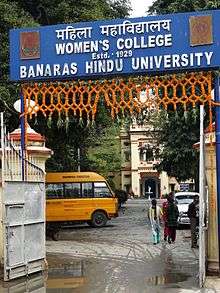
Schools
- Ranvir Sanskrit Vidyalaya,[67]
- Central Hindu Boys School[68]
- Central Hindu Girls School[69]
Library system
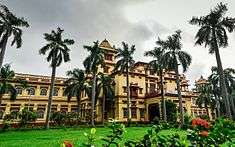
The Banaras Hindu University Library system was established from a collection donated by P.K. Telang in the memory of his father Justice Kashinath Trimbak Telang in 1917. The collection was housed in the Telang Hall of the Central Hindu College, Kamachha. In 1921, the library was moved to the Central Hall of the Arts College (now the Faculty of Arts).
The present Central Library of BHU was established with a donation from Maharaja Sayajirao Gaekwad III of Baroda. Upon his return from the First Round Table Conference, Gaekwad wanted a library built on the pattern of the British Library and its reading room, which was then located in the British Museum. On Malviya's suggestion, he made the donation to build the library on the BHU campus.[70]
The Gaekwad Library is a designated Manuscript Conservation Centre (MCC) of the National Mission for Manuscripts,[71] established in 2003.[72]
By 1931, the library had built a collection of around 60,000 volumes. The trend of donation of personal and family collection to the library continued as late as the 1940s with the result that it has unique pieces of rarities of books and journals dating back to the 18th century.
As of 2011, the BHU Library System consisted of the Central Library and 3 Institute Libraries, 8 Faculty Libraries and over 25 Departmental Libraries, with a collection of at least 1.3 million volumes.[70] The digital library is available to students and staff and provides online access to thousands of journals, besides access to large collections of online resources[73] through the National Informatics Centre's DELNET[74] and UGC's INFLIBNET.[75]
ICT infrastructure
The University has 100 kilometer long fiber optic backbone of Campus wide LAN, connecting all academic and administrative buildings as well as hostels with a well-equipped Computer Centre, providing high end computing and training facilities. The University has been provided three 1 Gbit/s nodes of National Knowledge Network (NKN) under NME-ICT.
Admissions
Banaras Hindu University conducts national level undergraduate (UET) and postgraduate (PET) entrance tests usually during May–June for admission for which registrations begin usually in February–March.[76] Admissions are done according to merit in the entrance tests, subject to fulfilling of other eligibility requirements. Admissions to B.Tech./B.Pharm., M.Tech./M.Pharm. are done through JEE and GATE respectively. Admission to MBA and MBA-IB are done through IIM-CAT score and also through separate BHU-MBA entrance tests. Admissions for Ph.D are done on the basis of either qualification of National Eligibility Test (NET) by the candidates or through the scores of CRET (Common Research Entrance Test). Admissions in IMS are done through PMT exam.
BHU attracts a number of foreign learners. Foreign students are admitted through the application submitted to the Indian mission in his/her country or by his/her country's mission in India.
BHU conducts UG entrance exam every year in May. The offline exam is held for 5166 seats. The total exam duration is 2 hours with 150 MCQs and the total marks is 450. There are seven participating colleges including BHU Faculty of Law and 6 constituent colleges.[77]
Halls of residence
BHU offers one of the best residential experience for students staying on the campus. Many of these hostels lie on one of the outer arc roads, facing large playgrounds. Most of these hostels have adequate mess facilities, common rooms, canteen, and residential quarters for wardens. Hostels like Birla, Lal Bahadur Shastri, Broacha and Vishvesvaraya have more than 300 rooms each.
In all, there are 41 hostels for male students with total intake capacity of around 7,500. For female students, there are 21 hostels with total intake capacity of around 2,500. There are four separate hostels for international students with total intake capacity of 189. These four include an International House Annexe for female students with an intake capacity of 24.
Festivals
BHU observes Saraswati puja day (also known as Vasant Panchami) as its foundation day. Goddess Saraswati is the Hindu goddess of knowledge, music, arts, wisdom and nature. She is a part of the trinity of Saraswati, Lakshmi and Parvati. There is also festival called SPANDAN ( Inter university youth festival) in this festival student represent their faculty/institute in various arts competition like literature (writing essay, poem, debates), Painting, sketches, vocal music, Dancing, singing, drama, mimicry etc. it's held every year after Vasant Panchami in month of February or March.
Rankings
| University rankings | |
|---|---|
| General – international | |
| QS (World) (2018)[78] | 801-1000 |
| QS (BRICS) (2018)[79] | 143 |
| QS (Asia) (2018)[80] | 225 |
| Times (World) (2018)[81] | 601-800 |
| Times (Asia) (2018)[82] | 194 |
| General – India | |
| NIRF (Overall) (2018)[83] | 9 |
| NIRF (Universities) (2018)[84] | 3 |
| Engineering – India | |
| NIRF (2018)[85] | 19 |
| The Week (2017)[86] | 9 |
| Medical - India | |
| India Today (2017)[87] | 10 |
| Outlook India (2017)[88] | 9 |
| The Week (2017)[89] | 6 |
| Law – India | |
| Outlook India (2017)[90] | 8 |
| The Week (2017)[91] | 7 |
| Business/Management – India | |
| NIRF (2018)[92] | 39 |
Internationally, BHU was ranked 801-1000 in the QS World University Rankings of 2018.[78] The same rankings ranked it 225 in Asia[80] and 143 among BRICS nations.[79] It was ranked 601-800 in the world by the Times Higher Education World University Rankings of 2018[81] and 194 in Asia.[82]
In India, the National Institutional Ranking Framework (NIRF) ranked it ninth overall in 2018[83] and third among universities.[84] It also ranked it 39 in the management ranking.[92]
It's engineering institute, IIT (BHU), was ranked 19 by the NIRF Engineering ranking for 2018.[85] In 2017, it was ranked 9th among engineering colleges in India by The Week.[86]
The Faculty of Law, Banaras Hindu University was ranked eighth in India by Outlook India's "Top 25 Law Colleges In 2017"[90] and seventh in India by The Week's "Top Law Colleges 2017".[91]
The Institute of Medical Sciences, Banaras Hindu University was ranked tenth among medical colleges in India in 2017 by India Today,[87] sixth by The Week[89] and ninth by Outlook India.[88]
Awards and medals
Following awards and medals are given to meritorious students in BHU-
- BHU Medal- BHU Medal is given to the students, who secure the first position in their respective departments or faculties.

Notable alumni, faculty and staff
Alumni and faculty of BHU have gained prominence in India and across the world. Among BHU's administrators was Sarvepalli Radhakrishnan, who went on to become the President of India. Other famous administrators have included, Sir Sunder Lal, K. L. Shrimali, Moti Lal Dhar and many others.
The university's alumni include Raj Narain, Rakhaldas Bandyopadhyay, C.N.R Rao, Madhav Sadashiv Golwalkar, Harivansh Rai Bachchan, Bhupen Hazarika, Shyam Sunder Surolia, Veena Pandey, A. K. Narain, Kamalesh Chandra Chakrabarty, Ashok Agarwal, Jagdish Kashyap, T. V. Ramakrishnan, Harkishan Singh, Narla Tata Rao, Patcha Ramachandra Rao, Jayant Vishnu Narlikar, Basanti Dulal Nagchaudhuri, Ahmad Hasan Dani, Kota Harinarayana, Kothapalli Jayashankar, Krishan Kant, Manick Sorcar, Satish K. Tripathi, Shashi P. Karna and Prem Saran Satsangi. Amongst its famous international students are Robert M. Pirsig and Koenraad Elst.
BHU's faculty have included Ganesh Prasad, Birbal Sahni, Shanti Swaroop Bhatnagar, Prafulla Kumar Jena,[93] Omkarnath Thakur, N. Rajam and A. K. Narain.
See also
References
- ↑ "Vice-Chancellor". www.bhu.ac.in. Retrieved 29 March 2018.
- 1 2 "History of BHU". Banaras Hindu University website.
- ↑ "University at Buffalo, BHU sign exchange programme". Rediff News. 4 October 2007.
- 1 2 "About the Campus". Krishi Vigyan Kendra, BHU. Archived from the original on 18 June 2012. Retrieved 3 June 2012.
- ↑ "Rajiv Gandhi South Campus". Krishi Vigyan Kendra, BHU. Retrieved 2012-06-03.
- ↑ "Banaras Hindu University keen to setup its Center in Bihar". IANS. Biharprabha News. Retrieved 1 February 2014.
- ↑ "UGC BHU Fact Sheet".
- ↑ "UGC Fact Sheet".
- ↑ "Submitted Institute Data for National Institute Ranking Framework - Banaras Hindu University, Varanasi" (PDF). NIRF. Retrieved 3 April 2018.
- ↑ "Banaras Hindu University: All rounder : 2011 - India Today". indiatoday.intoday.in. Retrieved 2015-11-10.
- ↑ "10 things to know about Madan Mohan Malviya". ABP Live. Retrieved 2015-11-10.
- ↑ "Founder of Banaras Hindu University: Mahamana Bharat Ratna Pandit Madan Mohan Malviya" (PDF). Banarash Hindu University. 2006. p. 18. Retrieved 2012-06-04.
- 1 2 "Founder of Banaras Hindu University: Mahamana Bharat Ratna Pandit Madan Mohan Malviya" (PDF). Banarash Hindu University. 2006. p. 19. Retrieved 2012-06-04.
- 1 2 Singh, Rana P.B.; Pravin S. Rana (2002). Banaras Region: A Spiritual and Cultural Guide. Varanasi: Indica Books. p. 141. ISBN 81-86569-24-3.
- ↑ "Founder of Banaras Hindu University: Mahamana Pandit Madan Mohan Malviya" (PDF). Banarash Hindu University. 2006. p. 12. Retrieved 2012-06-04.
- 1 2 "Bharat Ratna Pandit Madan Mohan Malviya: The Man, The Spirit, The Vision". Banaras Hindu University. Retrieved 2012-06-03.
- ↑ "Founder of Banaras Hindu University: Mahamana Bharat Ratna Pandit Madan Mohan Malviya" (PDF). Banarash Hindu University. 2006. p. 11. Retrieved 2012-06-04.
- ↑ "Founder of Banaras Hindu University: Mahamana Pandit Madan Mohan Malviya" (PDF). Banarash Hindu University. 2006. p. 30. Retrieved 2012-06-06.
- ↑ "The Banaras Hindu University Act, 1915". Indian Kanoon. Retrieved 2012-06-06.
- 1 2 "Madan Mohan Malaviya and Banaras Hindu University" (PDF). Current Science. Indian Academy of Sciences. 101 (8). 25 October 2011. Retrieved 2012-06-06.
- ↑ "A 'miser' who donated generously". thehindu. May 24, 2013.
- ↑ "Reminiscing the seventh Nizam's enormous contribution to education".
- ↑ http://missiontelangana.com/nizam-gave-funding-for-temples-and-hindu-educational-institutions
- ↑ "Heritage Complex". Banaras Hindu University. Retrieved 2012-06-04.
- ↑ "Student Amenities". Banaras Hindu University. Retrieved 2012-06-04.
- ↑ "Brief description". Benaras Hindu University website. Retrieved 7 March 2015.
- ↑ "Landmarks and Heritage of BHU". Banaras Hindu University. Archived from the original on 14 June 2012. Retrieved 4 June 2012.
- ↑ "History". Bharat Kala Bhavan. Retrieved 2012-06-04.
- ↑ "Collection". Bharat Kala Bhavan. Retrieved 2012-06-04.
- ↑ "Alice Boner Gallery".
- ↑ "History". RGSC, Banaras Hindu University. Retrieved 25 June 2015.
- ↑ "Research Projects". Krishi Vigyan Kendra, BHU. Retrieved 2012-06-04.
- ↑ "Infrastructure". Krishi Vigyan Kendra, BHU. Retrieved 2012-06-04.
- ↑
- ↑ "Departments".
- ↑ "Introduction". IIT Kanpur. Retrieved 6 October 2011.
- ↑ "IIT-BHU Act" (PDF).
- ↑ Ministry of Law and Justice (Legislative Department) (21 June 2012). "IT-Amendment-Act-2012" (PDF). The Gazette of India. Retrieved 21 September 2012.
- ↑ "Institutions of National Importance". Ministry of Human Resource Development, Government of India. Retrieved 25 June 2015.
- ↑ "Introduction". Institute of Agricultural Sciences, BHU. Retrieved 25 June 2015.
- ↑ "Welcome". Institute of Environment & Sustainable Development, BHU. Archived from the original on 18 May 2012. Retrieved 4 June 2012.
- ↑ "IESD".
- ↑ http://www.bhu.ac.in/fms/NofIoMS-BHU16Dec2015.pdf
- ↑ "Faculty & Institute, BHU". Bhu.ac.in. 19 August 2006. Retrieved 2011-08-19.
- ↑ "Welcome to "Faculty of Social Sciences"". Banaras Hindu University. Retrieved 8 February 2018.
- ↑ "Welcome to "Faculty of Social Sciences"". Banaras Hindu University. Retrieved 8 February 2018. Click "Centers".
- ↑ "Babu Jagjivan Ram Chair for Social Research (BJRC)". bhu.ac.in. Banaras Hindu University, Faculty of Social Sciences Varanasi. Retrieved 8 February 2018.
- ↑ "The Dr. B.R. Ambedkar Chair". bhu.ac.in. Banaras Hindu University. Retrieved 8 February 2018.
- ↑ "Pt. Deendayal Upadhyay Chair". bhu.ac.in. Banaras Hindu University. Retrieved 8 February 2018.
- ↑ "About Faculty of Visual Arts". BHU website. Retrieved 1 October 2015.
- ↑ "Home Page of Faculty of Science, BHU". Archived from the original on 2 April 2009.
- ↑ "About the department - School of Biotechnology, BHU". Archived from the original on 9 June 2012. Retrieved 4 June 2012.
- ↑ "Human Resource Development, Department of Biotechnology, Government of India". Archived from the original on 24 November 2011.
- ↑ "Lab web page of Prof. A. M. Kayastha, School of Biotechnology".
- ↑ "Central grant to BHU for school of life sciences". The Times of India. 7 October 2009. Retrieved 2012-06-04.
- ↑ "About us". DST Centre for Interdisciplinary Mathematical Sciences, BHU. Archived from the original on 19 June 2012. Retrieved 4 June 2012.
- ↑ "Overview". Centre of Food Science & Technology, BHU. Retrieved 2012-06-04.
- ↑ "Financial Support: Special Assistance Programme (SAP)". University Grants Commission. Retrieved 2012-06-04.
- ↑ "About CGD". Centre for Genetic Disorders, BHU. Archived from the original on 11 May 2012. Retrieved 4 June 2012.
- ↑ "Welcome". Centre for Environmental Science & Technology, BHU. Retrieved 2012-06-04.
- ↑ "CWSD".
- ↑ "CSN".
- ↑ "MCPR".
- ↑ "CIRD".
- ↑ "CSSEIP".
- ↑ "MMV".
- ↑ "RSV".
- ↑ "CHS".
- ↑ "CHGS".
- 1 2 "Genesis and history". Sayaji Rao Gaekwad Library, BHU. Retrieved 2012-06-04.
- ↑ "Manuscript Conservation Centres". National Mission for Manuscripts. Archived from the original on 6 May 2012. Retrieved 2012-06-04.
- ↑ "History". National Mission for Manuscripts. Archived from the original on 20 May 2012. Retrieved 4 June 2012.
- ↑ "Library Services". Banaras Hindu University. Retrieved 2012-06-06.
- ↑ "Developing Library Network". National Informatics Centre. Retrieved 2012-06-06.
- ↑ "Information and Library Network Centre". University Grants Commission. Retrieved 2012-06-06.
- ↑ "Application process" (PDF).
- ↑ "BHU UET".
- 1 2 "QS World University Rankings 2018". QS Quacquarelli Symonds Limited. 2017. Retrieved 12 June 2017.
- 1 2 "QS BRICS University Rankings 2018". QS Quacquarelli Symonds Limited. 2017. Retrieved 2 December 2017.
- 1 2 "QS Asian University Rankings 2018". QS Quacquarelli Symonds Limited. 2017. Retrieved 12 November 2017.
- 1 2 "Top 1000 World University Rankings 2018". The Times Higher Education. 2017. Retrieved 12 April 2017.
- 1 2 "Times Higher Education Asia University Rankings (2018)". The Times Higher Education. 2018. Retrieved 25 March 2018.
- 1 2 "National Institutional Ranking Framework 2018 (Overall)". National Institutional Ranking Framework. Ministry of Human Resource Development. 2018.
- 1 2 "National Institutional Ranking Framework 2018 (Universities)". National Institutional Ranking Framework. Ministry of Human Resource Development. 2018.
- 1 2 "National Institutional Ranking Framework 2018 (Engineering)". National Institutional Ranking Framework. Ministry of Human Resource Development. 2018.
- 1 2 Singh, Abhinav (18 June 2017). "The Week - Hansa Research Best Colleges Survey 2017: Top Engineering Colleges - All India". The Week. Retrieved 8 September 2017.
- 1 2 "India's Best Colleges 2017: Medical". India Today. 2017. Retrieved 21 June 2017.
- 1 2 "Top 25 Medical Colleges In 2017". Outlook India. 5 June 2017. Retrieved 21 June 2017.
- 1 2 Singh, Abhinav (18 June 2017). "The Week - Hansa Research Best Colleges Survey 2017: Top Medical Colleges - All India". The Week. Retrieved 8 September 2017.
- 1 2 "Top 25 Law Colleges In 2017". Outlook India. 5 June 2017. Retrieved 25 June 2017.
- 1 2 Singh, Abhinav (18 June 2017). "The Week - Hansa Research Best Colleges Survey 2017: Top Law Colleges - All India". The Week. Retrieved 8 September 2017.
- 1 2 "National Institutional Ranking Framework 2018 (Management)". National Institutional Ranking Framework. Ministry of Human Resource Development. 2018. Retrieved 3 April 2018.
- ↑ "Institute of Advanced Technology and Environmental Studies profile" (PDF). Institute of Advanced Technology and Environmental Studies. 2015. Retrieved 26 June 2015.
Further reading
- Leah Renold, A Hindu Education: Early Years Of The Banaras Hindu University (Oxford University Press).
External links
| Wikimedia Commons has media related to Banaras Hindu University. |
